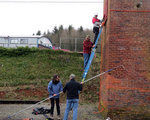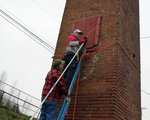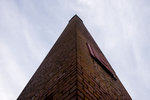






A familiar towering chimney in Chehalis once used to ventilate a brick kiln may soon become a kind of bird hotel twice a year for migrating Vaux’s swift — a small, sparrow-like bird native to the Northwest.
“It has become, so it seems, that chimneys are kind of essential to this species’ survival,” said Larry Schwitters, who has been instrumental in studying and tracking the Northwest’s population of Vaux’s swift in recent years. “We’ve also discovered that there’s only a dozen or so chimneys that shelter the vast majority of the birds in this species.”
Members of the Pilchuck and Black Hills chapters of the National Audubon Society worked over the weekend to make improvements to the unused antique chimney, which sits on property owned by Heritage Restoration on North National Avenue in Chehalis.
Starting in mid-April, volunteers plan to use recordings of swift calls to try to attract the northward-migrating birds to the chimney, where they will stay for a few days to rest before either continuing north or finding a more permanent residence in the area for the spring and summer.
As they migrate, the birds congregate by the thousands each night, huddling close together to share their body heat.
“It seems they have a hard time conserving their body heat. They’re not able to fluff up like most birds do,” said Schwitters, a member of the Pilchuck chapter of the Audubon society who is helping with the project to develop the Chehalis chimney as possible new habitat for the species.
In the past, the birds used to congregate in large, hollow, old-growth trees, but as that habitat has become more scarce along their migration routes, the birds adapted to new sources of shelter and now settle primarily in chimneys and other enclosed brick structures that can soak up heat during the day.
Finding suitable chimneys to inhabit is sometimes a problem. Schwitters said the migrating birds have been known to inhabit working chimneys, dying by the thousands when an unwitting maintenance worker fires up a boiler for the first time in the fall as they migrate south.
“Like most species, they’re in danger,” he said. “There are more critical endangered species. They are not officially endangered, but they are in danger.”
Schwitters said various estimates place the total number of Vaux’s swifts at between 200,000 and 340,000.
“We’ve had a fifth of the population in one chimney, which makes them particularly vulnerable,” he said.
Because of that vulnerability, it’s important to provide new habitat for the birds, he said.
“They’ve got a right to live. They’re part of the fabric of life — they matter,” he said.
The birds spend the winter in southern Mexico or Costa Rica, and in the spring start migrating as far north as the Yukon. Once they settle in a location, some of them in Washington, pairs of birds live in chimneys and lay eggs in nests stuck to the inside of chimneys.
“Chehalis probably has birds in residential chimneys,” Schwitters said. “One chimney, one nest, usually just Mom and Dad and five or six young.”
Schwitters and Audubon researchers have tracked the birds along their West Coast migratory route, and have identified four chimneys hosting large populations of migrating birds in Washington. They are located in Sedro-Woolley, Monroe, Selleck and Joint Base Lewis-McChord.
Black Hills Audubon members started scoping out Chehalis for swifts, since it sits between Lewis-McChord and the swifts’ next known stop in Portland.
“They were checking out the birds at the train station and we found out that Chehalis does have swifts but they weren’t necessarily going to the same place … and the numbers as the years went on dropped,” Schwitters said. “So we kind of lost track of where the Chehalis swifts were. We figure it’s a good place for swifts to be.”
Deb Nickerson, president of Black Hills Audubon, which covers Lewis, Thurston and Mason counties, first scouted the Heritage Restorations chimney as a possible location for the birds to rest.
“I’d just been thinking about it and wanting to take it on to see if we could … make it a place for swifts to roost when they’re on their way,” she said.
Nickerson said Schwitters took the initiative to set up meetings with Heritage Restoration to discuss using the chimney for the project.
“At first I didn’t know what to think about it,” said Kevin Godfrey, president of Heritage Restoration. “The first thing that goes through my mind is I don’t need 1,000 birds in my parking lot.”
Heritage Restoration sits on a site once used as a brick-making business. That enterprise shut down more than 40 years ago, but some evidence of its operations, including the one standing chimney, still remain, Godfrey said.
“We never took the chimney down because it was a part of … Lewis County history,” he said. “It’s definitely a conversation piece.”
After some research on the swifts and after talking with the Audubon members, Godfrey said he warmed to the project.
“It’s kind of exciting,” he said.
On Saturday, Audubon members plugged up a large hole near the base of the chimney, in an effort to make it more hospitable for the birds, who seem to prefer enclosed spaces, Schwitters said.
“We tried to sprinkle some swift poop in it so it would smell like home to them,” he said. “We didn’t get that done.”
Audubon members plan to continue making preparations for the birds’ migration in coming weeks.
When the birds start migrating north, starting in mid-April, volunteers plan to play a recording of a swift call for 30 minutes at dusk every night for up to six weeks in an effort to attract the birds, Nickerson said.
Before roosting for the night, the birds usually circle the area for about 20 minutes, calling to fellow swifts. The Audubon members are hoping to simulate that with the recording. They’ll track the birds as they head north from Oregon to gauge the best time to play the call.
“It’s kind of a long shot,” Schwitters said. “Let’s say 40 percent possibility. It’s something that’s never been tried with this species.”
However, the technique has been used on other swift species effectively, he said.
“I think what we’ll do definitely is keep going. Even if it doesn’t happen this spring we’ll try it again in the fall,” Nickerson said.
Nickerson is looking for local volunteers to help with the project. To volunteer, contact the Black Hills Audubon Society at 4info@blackhills-audubon.org.